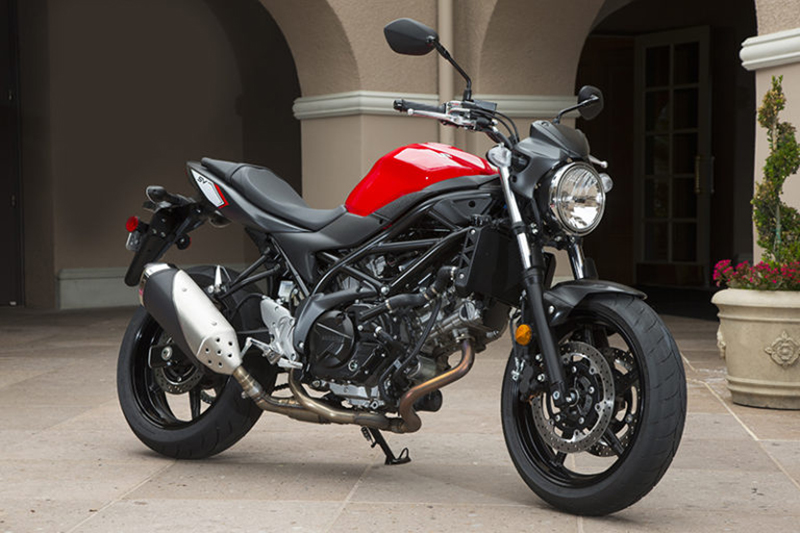2017 Suzuki SV650

First Ride Review
Sixteen years ago I walked into a dealership ready to buy my first brand-new bike: a 2000 Suzuki SV650 in Candy Grand Blue. I’d done my homework; the SV650 had been released the year before and had already earned respect from riders both new and experienced. It was the rarest of creatures: inexpensive, fun and easy to ride for beginners, yet powerful and nimble enough to keep you interested after the learning stage…and possibly even flirt with racing.
The SV650 received various improvements over the years, some desirable (fuel injection and ABS), some not so desirable (2009’s ill-advised makeover as the Gladius), and the pre-Gladius models still enjoy a robust used and aftermarket parts market. With the launch of the 2017 SV650, Suzuki is clearly looking to evoke the spirit of the 1999 original, returning to what made it such a great bike in the first place. The trellis frame is back (steel though, rather than aluminum), as is the round headlight and minimalist styling. The year 1999 was a long time ago, however, and in the intervening 17 years several modern bikes have taken up residence in the middleweight naked fun-bike category, most recently the Ducati Scrambler and Yamaha’s outstanding FZ-07. A reboot of the ’99 model with just a facelift and BNG (Bold New Graphics) won’t cut it.
Based on a day spent railing through twisting canyons, slabbing down the freeway and creeping through urban traffic during the U.S. launch in Pasadena, California, the new SV650 seems to embody everything I loved about my original, in a more refined package and with enough modern conveniences to make it feel fresh. Some riders will like its classic, understated styling, others may find it a bit plain compared to the competition, but once you’re on board you’ll be hard-pressed not to smile.
The SV has always been approachable, and this new iteration is no different. With a low 30.9-inch seat height and a claimed curb weight of 430 pounds (15 pounds less than the 2015 Gladius but a whopping 33 more than the FZ-07), the SV is inviting to beginners and smaller-statured riders. One 5-foot, 2-inch tester with a 29-inch inseam was able to put the balls of both feet solidly on the ground. The gas tank is 2.5 inches narrower than the 2015 model, while maintaining the same fuel capacity (3.8 gallons, or 3.6 for the California model), and the area where the side panels, seat and gas tank meet is as slim as possible to help the rider reach the ground. The seat, however, seems to have been trimmed to the bare minimum. By the end of our 125-mile day, my bottom was telling me it wouldn’t be pleased with a longer ride.
Interestingly enough, while its design is clearly meant to appeal to smaller riders, the SV’s non-adjustable (except for 7-position rear preload) suspension is set up for a 165-to-175-pound rider. Perhaps a nod to its potential beyond just a “beginner bike?”
Despite its low price point, the little SV features a few modern accouterments, such as available ABS, a digital instrument cluster that includes a gear indicator, fuel range remaining, fuel gauge and consumption data; and Suzuki’s one-touch Easy Start System. One feature that contributes to its beginner-friendly appeal is also the coolest: the Low RPM Assist. Activated by a switch on the clutch lever, the system raises engine speed during takeoff and low-speed operation, effectively preventing the rider from stalling. I had plenty of opportunities to test this feature in the stop-and-go Pasadena traffic, and am happy to report that it works pretty darn well! From a stop, simply release the clutch lever and the bike rolls gently forward—you don’t even need to touch the throttle until you’re ready to accelerate past walking speed.
Speaking of accelerating, the SV’s liquid-cooled 645cc, 90-degree V-twin is probably one of the smoothest twins I’ve ever ridden. With 75 horsepower and 47 lb-ft. of torque (claimed), it’s also not boring, with enough spunk to keep a brisk pace in the twisties and squirt through commuter traffic. Suzuki has continuously refined this powerplant since its introduction for the 1999 SV650, and this year it features more than 60 new parts such as new pistons with resin-coated skirts, L-shaped upper piston rings and revised 39mm throttle bodies with dual throttle valves, which Suzuki says combine to produce more power and better fuel economy than the 2015 model. Handling is brisk as well; the SV is easy to toss through corners and exhibited no skittish or unpredictable behavior, even when I made mid-corner adjustments. The brakes (I was on a non-ABS model) offered good feel and didn’t stand out in any way, which I consider a positive; if you aren’t thinking about how your brakes are working, they’re likely doing their job.
Suzuki appears to have succeeded in its mission to reincarnate the SV650, but the question remains: is it enough to stand out in an increasingly crowded mid-size naked bike market? We look forward to getting our hands on one for a longer look.
